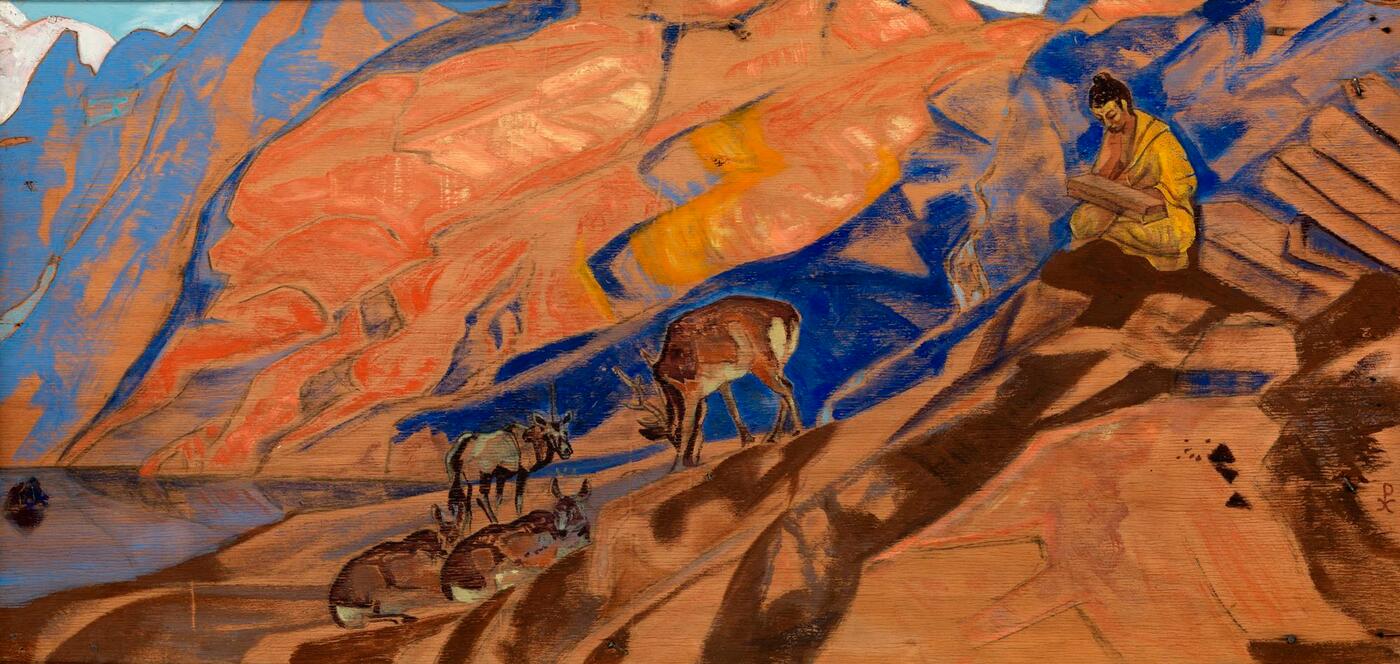MacDougall's Russian Art Auctions 1-2 Dec 2010
1 December 2010

* 309. ROERICH, NICHOLAS 1874-1947
Commands of the Teacher signed with a monogram, also numbered "N4", dated 1927 by the artist and further numbered "RM697" by the Roerich Museum on the reverse
Tempera on panel, 35 by 78 cm.
300,000-400,000 GBP
Provenance: Roerich Museum, New York, 1927–1935.
Nettie & Louis Horch collection, USA, from 1935.
Dr Carlos Giro collection, USA.
Acquired from the above by the present owner.
Exhibited: Roerich Museum, New York (permanent collection), 1927–1935, no. 697.
Literature: The Mystic East Inspires Nicholas Roerich's Paintings, New York Times Mid-Week Pictorial, October 29, 1927, illustrated.
Roerich Museum Catalogue, 8th ed.New York, Roerich Museum, 1930, p. 29, no.697.
V. Ivanov, E. Gollerbach, Roerich, Vol. 1, Riga, 1939, p. 106, illustrated.
Commands of the Teacher is one of the paintings that Nicholas Roerich completed while staying in the Mongolian capital Ulaanbaatar. From September 1926 until April 1927, he was preparing for the journey to Lhasa where he intended to meet the Dalai Lama. This expedition, which involved the incredible feat of crossing Mongolia and Tibet from north to south, was the culmination of Roerich’s serious interest in Buddhism as a philosophical and moral teaching. The whole family was deeply involved in Buddhist studies at that time: his wife Helena wrote and published Foundations of Buddhism (in Ulaanbaatar, in 1927) and his son George was already making a career as an oriental scholar by publishing several works on Buddhist subjects. Not surprisingly, Roerich’s most important paintings from this period, including the present one, have Buddhist connotations.
Before leaving for Lhasa, Roerich sent his works to New York, and in October, New York Times Mid-Week Pictorial had a full page report on their arrival with several reproductions, including Commands of the Teacher. The article said that "the artistic record of the Roerich expedition to Asia headed by Nicholas Roerich, an artist of international reputation, has been enriched by the recent arrival of more than 100 paintings by Professor Roerich, which have come back from the heart of Mongolia. The paintings recently reached the Roerich Museum in New York after a lengthy journey from Ulan Bator Khoto, Mongolia, across the world to America. They will be added to the present collections of the Roerich Museum and will be opened to the public for the first time on Nov. 17, 1927, the fourth anniversary of the foundation of the museum." (The Mystic East Inspires Nicholas Roerich’s paintings, Mid-Week Pictorial, October 29, 1927.) The five paintings reproduced therein were undoubtedly chosen by Roerich himself, and the inclusion of Commands of the Teacher testifies to its significance.
The painting presents a Buddhist disciple reading from a xylograph on the shores of a mountain lake. The scenery is somewhat suggestive of Lake of Nagas and Nagarjuna, the Conqueror of the Serpent, two other paintings with Buddhist elements from 1925. The disciple himself is a highly advanced adept and has achieved a Buddha’s enlightenment, which is indicated by the ushnisha, the supernatural cranial protuberance. The deer pasturing at his feet are another reminder of Buddhahood, which allows for the miraculous power of taming wild animals.
The title of the painting helps us to understand the main idea of this panel: though a Buddha in his own right, the adept has a teacher, someone even more advanced than himself. Roerich was very fond of the idea of endless spiritual growth by virtue of an unbroken, hierarchical line of Masters. The concept of "commands" reveals the active nature of the master-disciple relationship. Instead of associating the teaching with abstract metaphysical postulates, Roerich invokes the idea of practical down-to-earth tasks, in line with the Buddhist principle that the path to enlightenment is first and foremost the path of serving humanity.
There is a later variant of this painting entitled Book of Life (c. 1930s), in which the whole scene is moved from the ground level up into the high mountains. The adept and animals are distanced from the viewer and enclosed in a translucent, eerie light. By contrast, the original painting is a more direct and forceful interpretation. Executed on a rough panel with holes and several nails still intact (it must have originally served as construction material), the work has an unfinished feel, as if the artist lost interest in polishing the details as soon as his idea came alive. The expressivity of the lines and overall roughness emphasizes the "action-rather-than-meditation" message of the artist. At the same time, the recipient of commands maintains his intense mental focus despite the wild undulations of blue and orange rocks behind him. While his body seems to be almost of the same quality as the surrounding rocks, his mental presence commands the surroundings.
We are thankful to Gvido Trepša, Senior Researcher at Nicholas Roerich Museum, New York, for providing catalogue information.
Notes on symbols:
* Indicates 5% Import Duty Charge applies.
Ω Indicates 20% Import Duty Charge applies.
§ Indicates Artist's Resale Right applies.
† Indicates Standard VAT scheme applies, and the rate of 20% VAT will be charged on both hammer price and premium.